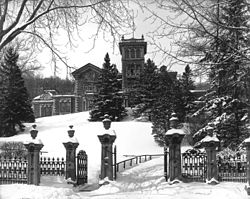Square Mile / Golden Square Mile | |
|---|---|
 Ravenscrag, built for Sir Hugh Allan in 1863 | |
Location of the Square Mile in Montreal | |
| Coordinates: 45°30′04″N 73°34′56″W / 45.501111°N 73.582222°W | |
| Country | Canada |
| Province | Quebec |
| City | Montreal |
| Borough | Ville-Marie |
| Postal Code | |
| Area code(s) | 514, 438 |
The Golden Square Mile (French: Mille carré doré, pronounced [mil kaʁe dɔʁe]), also known as the Square Mile, is the nostalgic name given to an urban neighbourhood developed principally between 1850 and 1930 at the foot of Mount Royal, in the west-central section of downtown Montreal in Quebec, Canada. The name 'Square Mile' has been used to refer to the area since the 1930s; prior to that, the neighbourhood was known as 'New Town' or 'Uptown'.[1] The addition of 'Golden' was coined by Montreal journalist Charlie Lazarus, and the name has connections to contemporary real estate developments, as the historical delimitations of the Golden Square Mile overlap with Montreal's contemporary central business district.
From the 1790s, the business leaders of Montreal looked beyond Old Montreal for spacious sites upon which to build their country homes. They developed the farmland on the slopes of Mount Royal north of Sherbrooke Street, creating a neighbourhood famous for its grandeur and architectural audacity. At the Square Mile's peak (1850–1930), its residents included the owners and operators of the majority of Canadian rail, shipping, timber, mining, fur and banking industries. From about 1870 to 1900, 70% of all wealth in Canada was held by this small group of approximately fifty men.[2]
By the 1930s, multiple factors led to the neighbourhood's decline, including the Great Depression, the dawn of the automobile, the demand for more heat-efficient houses, and the younger generations of the families that had built these homes having largely moved to Westmount.[3][4] During the Quiet Revolution, some of the businesses created in Montreal, on whose fortunes the Square Mile had been built, moved to Toronto.[citation needed] In this period, the Square Mile evolved to gradually become the central business district, and many of its grand houses were demolished. The face of the Square Mile was altered, leading to the formation of Heritage Montreal to preserve historic architecture in the city.
By 1983, only 30% of the mansions in the northern half of the Square Mile had survived demolition; and only 5% survived south of Sherbrooke Street.[5] Many of the remaining mansions, such as the James Ross House, today known as Chancellor Day Hall,[6] are today owned by McGill University. Nevertheless, the mansions of the Golden Square Mile represent a prosperous period during which Montreal was the cultural and financial capital of Canada.
- ^ Discover Montréal: an architectural and historical guide - Joshua Wolfe, Cécile Grenier, 1991
- ^ Patricia Harris; David Lyon (2 November 2004). "Golden Square Mile". Compass American Guides: Montreal. Fodor's. pp. 132–135. ISBN 978-1-4000-1315-9. Retrieved 5 December 2011.
- ^ "Canada's Richest Neighbourhoods, 2013". canadianbusiness.com. Canadian Business.
- ^ "Income by postal code: Mapping Canada's richest and poorest neighbourhoods".
- ^ Rémillard, François; & Brian Merrett (1987). Mansions of the Golden Square Mile. Meridian Press. ISBN 2-920417-25-8
- ^ Johnson, David. "Chancellor Day Hall (formerly James Ross House)". cac.mcgill.ca. Retrieved 2018-03-28.

